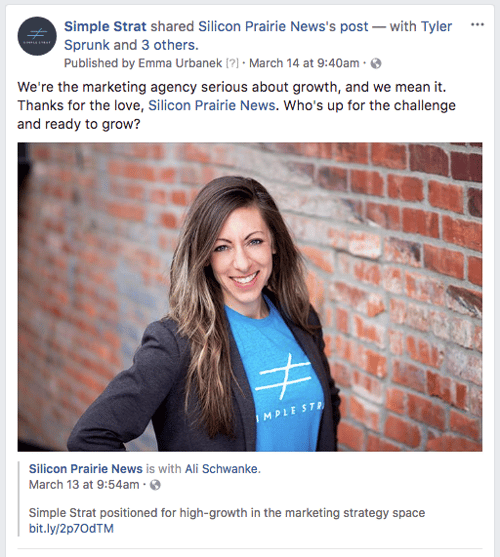Despite all of the ways to promote your content online, there is still one silver bullet if you can manage to track it down.
The secret? Getting a news outlet to publish a press release or story on your business.
When your company is covered in the news, whether that be a traditional news outlet, a blog, podcast, or magazine, it tells the rest of the world that you're the real deal. People start paying attention when someone else promotes your story. Plus, it's a great asset for inbound marketing!
When we discuss this with our clients, we call this phenomenon "external credibility" or "social proof". Positive and widespread coverage of your company can increase brand visibility, strengthen your reputation, help you acquire users, and land on the radar of investors and strategic partners.

When done right, it can be a significant accelerator for your marketing efforts, especially when you're trying to make the most of a modest budget.
But the PR world is just as cluttered as social media - so how do you generate PR coverage for your company?
To get PR coverage for your company, you need to do 5 things:
- Identify a PR Trigger (and the right timing)
- Outline your strategy (including a good story angle)
- Craft the content (well written pitches, releases, and multimedia)
- Create a lists of target journalists and media outlets
- Be persistent
Let's dig into each of these and how they fit together for a successful PR effort for your company.
1. Identify a PR Trigger
By pure definition, the word "news" means "newly received or noteworthy information, especially about recent or important events". You can't land PR without something significant to say that will appeal to readers or viewers.
Common PR triggers may include:
- Announcement of investment or new partnerships
- New company management or key employees
- Response to a current event or trend
- Awards or certifications
- Landing on a national list or securing a large influential contract
Be creative! The best way to identify triggers, specifically for your industry, are to read/review the outlets that your competitors or partners are in. What are the articles about? Can you spot specific topics or themes?
For example, we've identified the following PR triggers relevant to our company:
- Any response to a social media change or disruption (such as the Facebook data crisis)
- Events or conferences we may be speaking at
- Investment or new partnerships
- Product announcements
- Stories about our founders or employees
- Community service projects
- Trends or changes in the marketplace, such as smartphone adoption and how that impacts consumers internet habits and how businesses are affected by this
- Awards or certifications we've achieved
The list goes on! With having your team aware of the PR triggers inside your company, coming up with a list of "newsworthy" topics shouldn't be something that happens once. It should be ongoing. Make this a standard practice in your company's marketing efforts.
Don't forget about the importance of timing as well. If you're going to reach out for a holiday edition of a print magazine, reaching out in November will result in little to no success at all -- most magazines are planning Christmas content in June. Think ahead to identify calendar driven triggers as well. If you haven't thought about calendar-driven initiatives, you probably need to think through your marketing strategy and plan first!
2. Outline your strategy
PR is more than a one-time mention by a noteworthy outlet. It's part of your larger marketing strategy, and should be mapped accordingly.
When you're identifying your PR strategy, take a step back and first ask yourself:
- What do I hope to accomplish through PR?
- How will I measure success?
- Besides the placement of the PR, what else will I do to maximize the reach of published articles, posts, features, etc?
- Who is essential to carry out the strategy?
- What resources will I need?
One of the benefits of PR in today's market is that you'll gain additional exposure through social media. Most outlets will feature your story on social media and you can share this, promote it through advertising, and add this to your own content promotion calendar (this is what we do when we land PR for ourselves or for clients!).

You'll also want to think about how you might build a library of PR on your website that summarizes your coverage. By putting all of these articles or mentions in one place, your audience will begin to see the credibility points add up! Check out our press page here.
Once you've nailed down the overarching strategy, then you need to figure out your content angle for each specific PR opportunity.
The content angle, or PR angle, is what makes your story unique and relevant to readers or viewers. It's also called the "hook" if you're talking to more traditional PR folks. Regardless of what you call it, you can't have a successful PR strategy without it.
A good content angle will draw the reader in and engage them to read the rest of the story. It's what gets the reporter excited about exploring the story and getting your pitch into the hands of the editorial team.
3. Craft the content
Many companies will go to the hassle of writing a press release, but then struggle to get it picked up. Why? They haven't thought about the angle in advance. With the plethora of news topics, journalists have no shortage of releases. But what they want is a good angle that resonates with their readers (which we talked about in point #2).
As a result, we advise the writing of the content to take shape in two ways. First, you'll need a "pitch". This is a suggested story idea sent to individual journalists or reporters. It provides a quick overview of what the story would be about, the hook, and why it would be relevant and/or enticing to readers. PR pitches are shorter than press releases and typically follow the same format, but are customized to each reporter or journalist.
The last thing you want is to send the same pitch to multiple journalists at the same company - that's a recipe for disaster since reporters talk to one another!
Second, you'll want to write a press release. It's important to have this in your back pocket if the outlet does respond and ask for more information. Or, you may find it helpful to attach the press release to the pitch email.
In an article by HubSpot, they note that a press release is an official announcement (written or recorded) that an organization issues to the news media and beyond. Whether it's called a "press release," a "press statement," a "news release," or a "media release," these are usually the same thing (potato, potatoe right?).
Press releases also make it possible to publish on the news outlets such as PRWeb.com. A formal press release will often get picked up if the topic is relevant to the news or industry, and there is also an angle at play. That being said, make sure you're sticking with the facts. Reporters don't appreciate embellishments or things that cannot be backed up with facts. Answer the W's - who, what, where, when, and why.
The facts help establish that credibility we talked about earlier. Plus, an accurate, positive story helps contribute to your overall footprint online, which research shows is much more effective at engaging prospective customers than ads (specifically for B2B marketing).
And....don't forget to publish the news on your website as well once you've gotten through your initial pitches!

4. Create a list of journalists/reporters and news outlets
Once you have the release, you'll need to know WHO you want to send it to. Characteristics of individuals who would want to be on your outreach list include:
- Traditional news outlets (local or national depending on your focus and reach); this includes newspaper, TV, local magazines, local business publications, etc.)
- Industry-specific outlets; this includes industry-specific magazines and websites
- Freelance journalists that write for a number of outlets but typically have an industry or topical focus
The information you want to gather in order to be the most effective with your outreach includes:
- Outlet name
- Any submission/PR guidelines and/or what they typically cover
- Submission email or individual email (for a reporter)
- Phone number
- First and last name (if pitching to a reporter)
- Twitter handle
Twitter is a great way to tag a journalist about a particular news idea. Many companies overlook this, so having the outlet or reporter's twitter handle in front of you as you're doing outreach can be helpful.
5. Be persistent in your efforts.
PR is a little like sales. It may take a few attempts, or dozens, to generate interest in your company or story. A startup in our city is famously quoted as saying they reached out over 70 times before they finally landed a spot on a national TV show!
This isn't to say that you should persist at all costs, however. If a reporter or outlet responds to you and says your story is not relevant or they do not wish to cover it at this time, don't continue to hound them about it. Simply accept this, and then work on another angle for the future.
If you're looking for a few other tips on pitching and outreach specifically, check out this post on Forbes about 13 Do's and Don't's of Pitching Journalists.
The key to continuous PR coverage is to build relationships with reporters and outlets. In doing this, they'll know to seek you out when they're looking for an expert on a specific topic. Continuous PR is a great asset to any marketing strategy!
Conclusion
As you can see, PR helps you establish and grow your brand in a cost-effective, tangible way. Generating PR for your company doesn't have to be complicated, but it does need to be methodical and strategic. Let's recap the 5 steps you need to get started:
- Identify a PR Trigger (and the right timing)
- Outline your strategy (including a good story angle)
- Craft the content (well written pitches, releases, and multimedia)
- Create a lists of target journalists and media outlets
- Be persistent
If after reading all of this, you still have questions or want a partner to help you grow your company through PR, please drop us a note or comment below!



